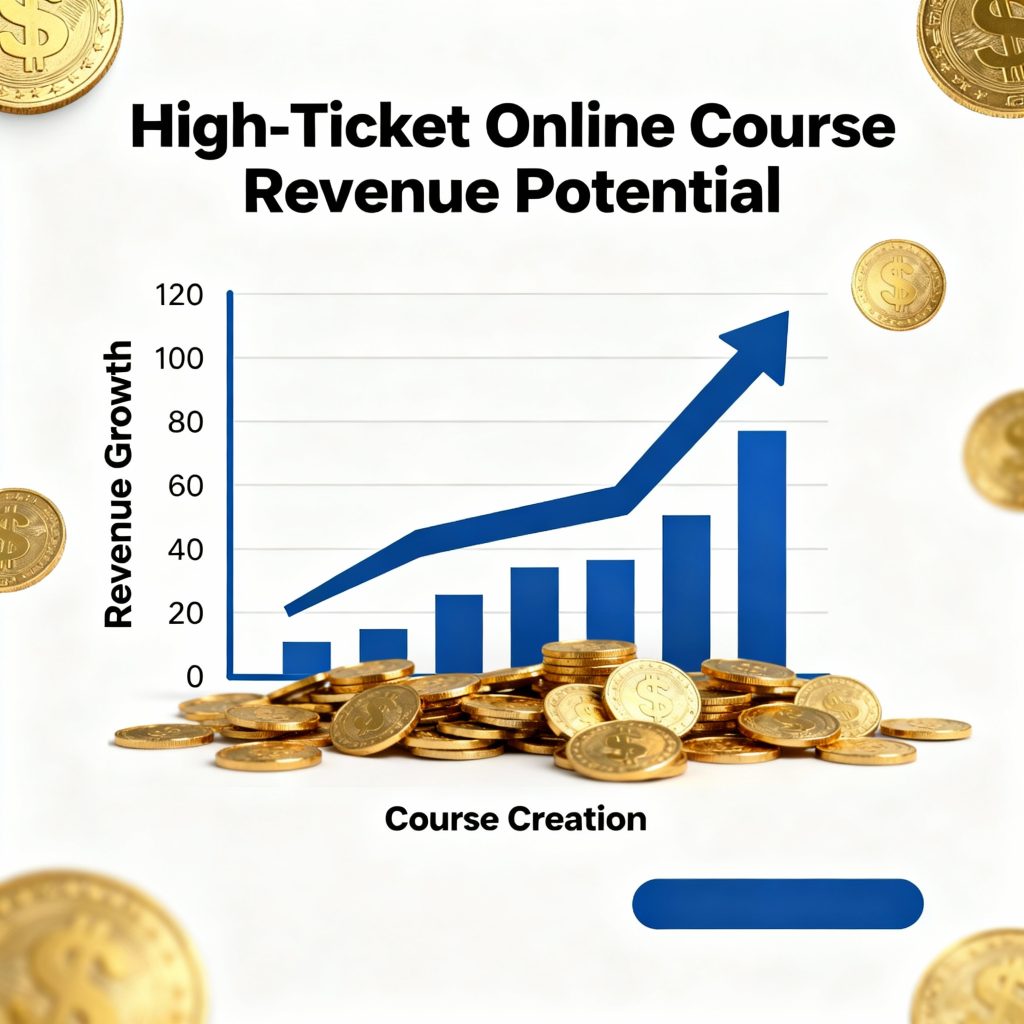The online education revolution has created unprecedented opportunities for entrepreneurs and subject matter experts to transform their knowledge into substantial income streams. With the global online education market projected to reach $319 billion by 2025, course creators who understand the fundamentals of high-ticket course development can build businesses generating $100,000 to $1,000,000+ annually.
Understanding the High-Ticket Course Market
Market Size and Growth Trajectory
The online course industry has experienced explosive growth, with the massive open online courses (MOOCs) market alone valued at $26 billion in 2024 and estimated to grow at 39.3% CAGR through 2034. This growth is driven by increasing internet penetration, with 5.5 billion users worldwide seeking flexible learning solutions.
The e-learning sector is experiencing remarkable expansion across multiple segments:
- Corporate e-learning driving significant growth toward a projected $240 billion market
- 900% increase since 2000 in overall market valuation
- Online education representing 15.9% of the global education market by 2025
Revenue Potential for Course Creators
Successful course creators demonstrate substantial earning potential across different experience levels:
Income Ranges by Creator Level:
- Beginners: $200-$1,000 per month (part-time creators testing concepts)
- Intermediate: $3,000-$10,000 per month (validated topics with solid marketing)
- Advanced: $100,000+ annually (refined funnels and repeat customers)
- Top Performers: $1,000,000+ annually (premium positioning and comprehensive programs)
Real-world success stories validate these projections. Recording Revolution founder Graham Cochrane generates over $1.2 million annually working only five hours per week through his online music production courses. Similarly, one LearnWorlds creator generated $104,000 from a single $1,000 high-ticket program launch.
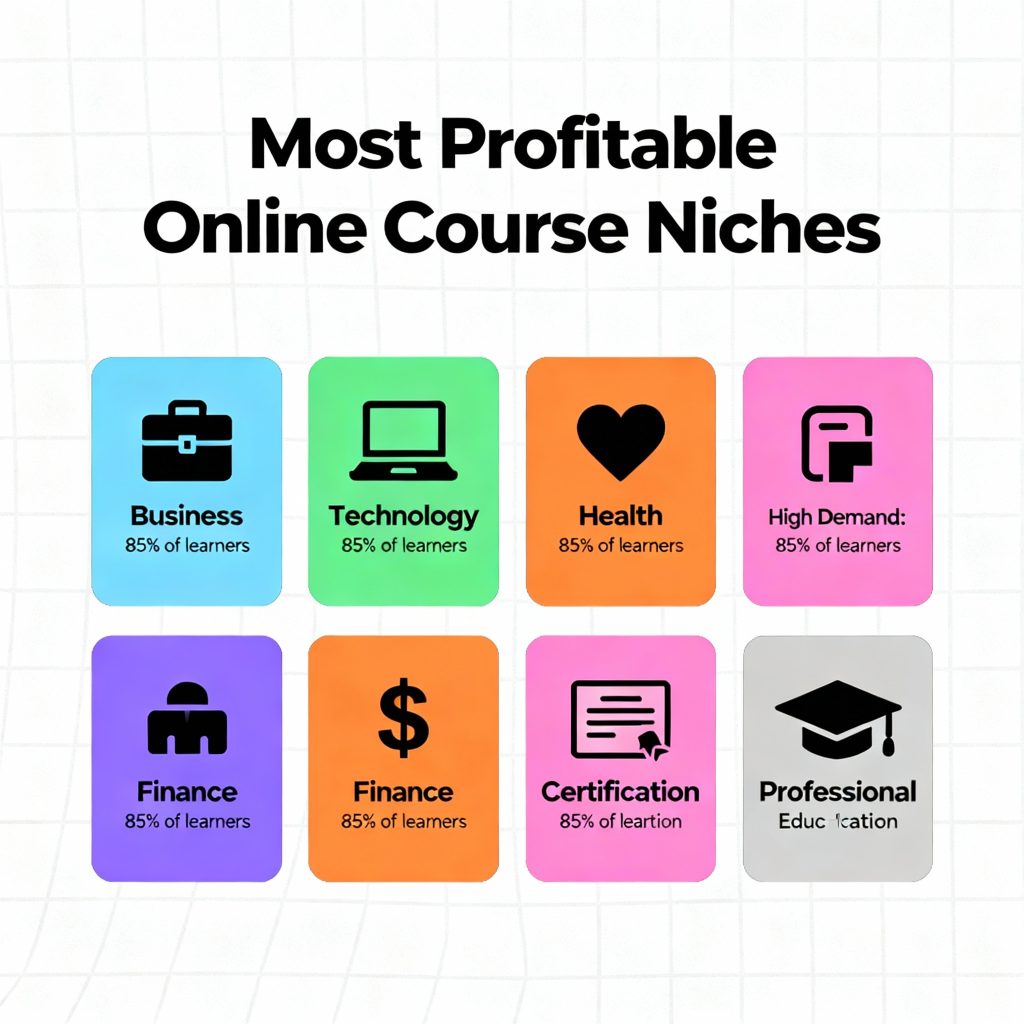
Most Profitable Course Niches
Evergreen High-Value Niches
The most profitable course categories consistently solve urgent business problems or provide measurable skill development:
Business & Entrepreneurship ($500-$2,000 per student)
- Business development and strategy
- Leadership and management
- Startup acceleration programs
- Digital transformation consulting
Technology Skills ($300-$1,500 per student)
- Web development and programming
- AI and machine learning applications
- Cybersecurity certification
- Data science and analytics
Personal Finance & Investment ($400-$1,200 per student)
- Investment strategies and portfolio management
- Real estate investing
- Cryptocurrency and trading
- Financial planning and wealth building
Professional Certification Prep ($200-$600 per student)
- Project management (PMP, Agile)
- IT certifications (AWS, Google Cloud)
- Industry-specific licensing
- Professional development programs
Emerging High-Growth Niches
These rapidly expanding markets offer exceptional opportunities for early movers:
AI and Machine Learning (22% CAGR growth)
- Generative AI for professionals
- Ethical AI implementation
- Industry-specific AI applications
- AI tool mastery for non-technical users
Health and Wellness ($200-$800 per student)
- Holistic health approaches
- Mental wellness and mindfulness
- Fitness specialization programs
- Nutrition and lifestyle coaching
Digital Marketing (13.31% CAGR growth)
- Social media strategy and automation
- Content marketing systems
- SEO and digital advertising
- Influencer marketing strategies
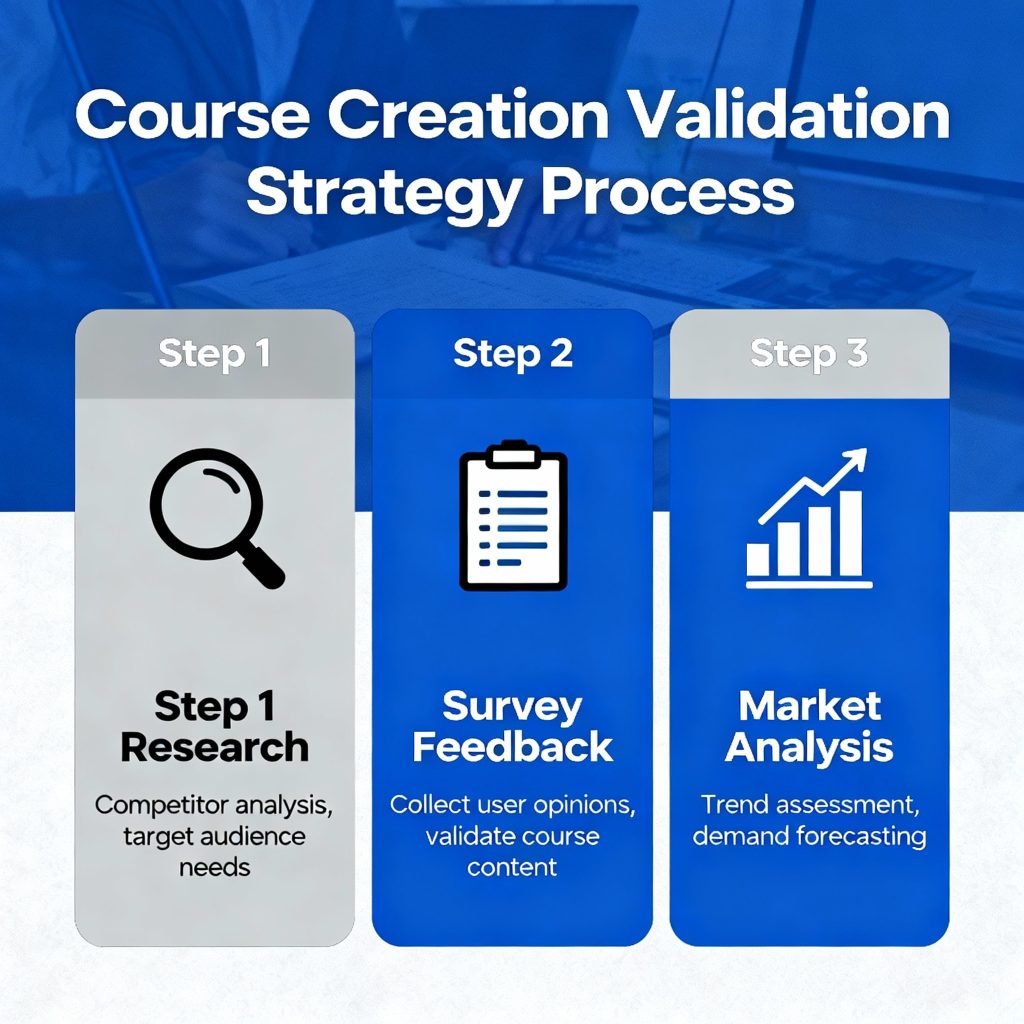
Course Validation Strategy
Pre-Launch Validation Methods
Successful course creators validate demand before investing significant time in content creation:
1. Pre-Selling Approach
Pre-selling your course concept provides the most direct validation of market demand. Create a compelling course outline and pricing structure, then attempt to secure enrollments before building the full curriculum. If you can generate 20-50 pre-sales, you have strong validation for proceeding with development.
2. Market Research Analysis
Utilize multiple data sources to assess demand:
- YouTube Analytics: Search for your topic and analyze video metrics. High view counts and engagement indicate strong interest
- Udemy Marketplace Insights: Research existing courses in your niche to understand pricing and demand
- Google Trends and Keyword Research: Identify search volume and trending topics
- Social Media Listening: Monitor discussions on Reddit, Quora, and Facebook groups
3. Survey and Poll Strategy
Develop targeted surveys focusing on specific pain points and willingness to pay. Key questions should address:
- Current challenges and frustrations
- Solutions already attempted
- Budget allocation for learning
- Preferred learning formats and timeframes
4. Landing Page Testing
Create a professional landing page describing your course concept and measure conversion rates from traffic to email signups or pre-sales inquiries.
Competitive Analysis Framework
Understanding your competitive landscape helps position your course effectively:
- Analyze similar courses’ pricing structures and content depth
- Identify gaps in existing offerings that your course could address
- Assess competitor marketing strategies and student feedback
- Calculate potential market size based on competitor enrollment data
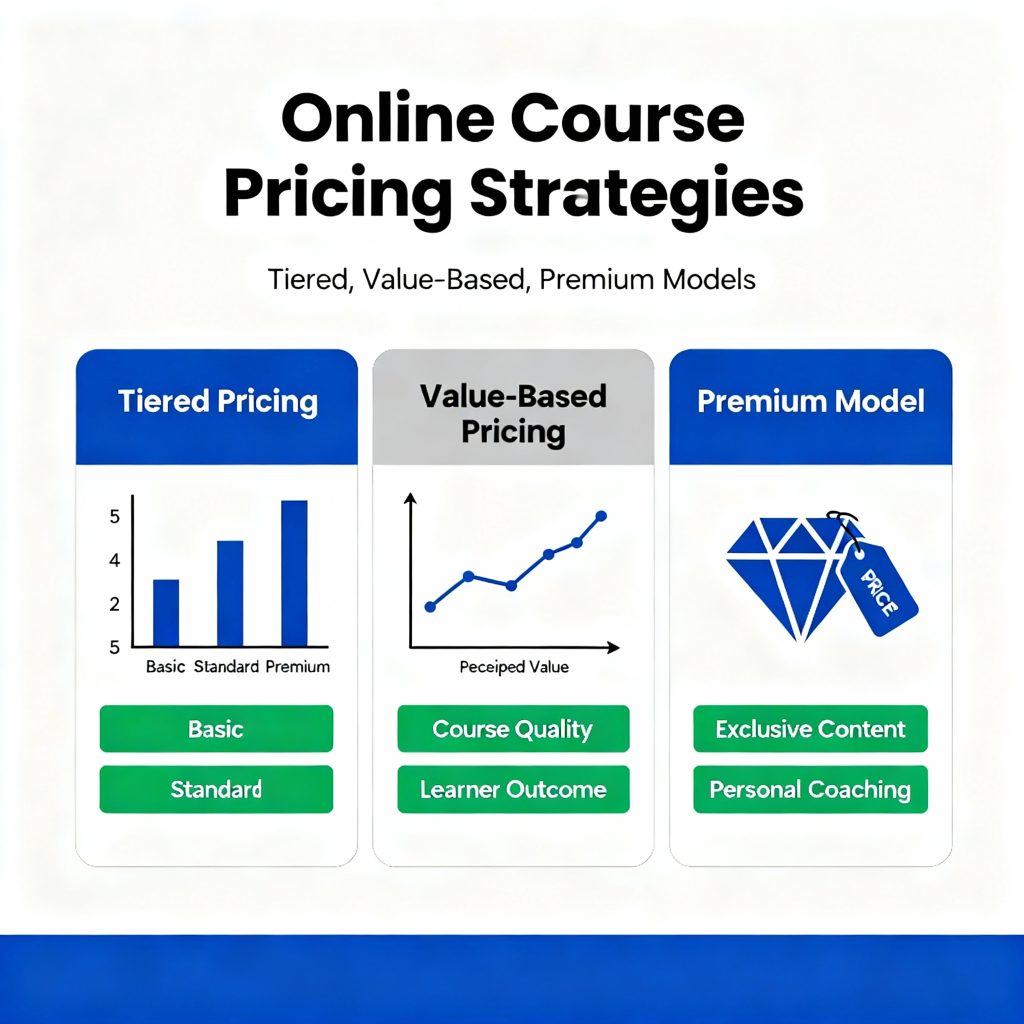
Pricing Strategies for High-Ticket Success
Value-Based Pricing Foundation
High-ticket courses must justify their premium pricing through demonstrated value and transformation. Price based on the outcome and transformation your course delivers, not the time investment required to create it.
Transformation-Focused Pricing Elements:
- ROI Calculation: If your course helps someone earn an additional $50,000 annually, a $5,000 price point becomes highly attractive
- Time Savings Value: Quantify how much time your course saves students and price accordingly
- Competitive Advantage: Price based on the unique positioning and exclusive access your course provides
Tiered Pricing Architecture
Successful high-ticket courses often employ sophisticated pricing tiers to maximize revenue per student:
Basic Tier ($500-$1,500)
- Core curriculum access
- Basic community participation
- Standard email support
- Downloadable resources
Premium Tier ($2,000-$5,000)
- Everything in Basic
- Live group coaching sessions
- Direct instructor access
- Advanced bonus modules
- Certification upon completion
VIP Tier ($5,000-$15,000)
- Everything in Premium
- One-on-one coaching sessions
- Personalized feedback and review
- Priority support and access
- Done-with-you implementation
Dynamic and Psychological Pricing
Advanced pricing strategies can significantly impact enrollment and revenue:
Launch Sequence Pricing:
- Founding Member Rate: 30-50% discount for first 48-72 hours
- Early Bird Pricing: 20-30% discount for first two weeks
- Regular Pricing: Full price after promotional periods
Psychological Pricing Techniques:
- Anchoring: Present highest-tier pricing first to make other options appear more affordable
- Charm Pricing: Use $997 instead of $1,000 for easier mental processing
- Scarcity Creation: Limit enrollment numbers or time-based availability
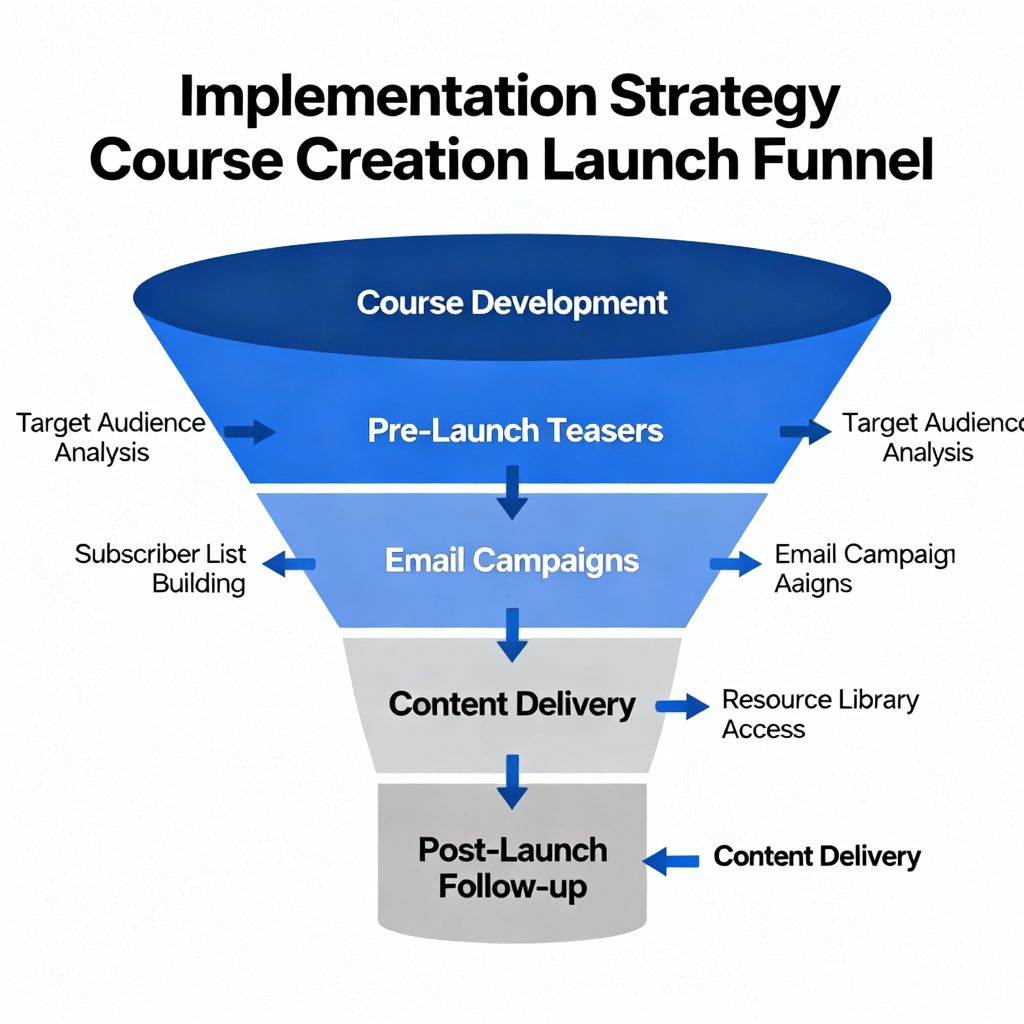
Implementation Strategy
Course Structure and Content Development
High-ticket courses require sophisticated curriculum design that justifies premium pricing:
Modular Framework Design:
- Foundation Module: Establishing baseline knowledge and mindset
- Core Skill Modules: 4-6 focused modules building progressive competency
- Advanced Application: Real-world implementation and case studies
- Integration Module: Putting all elements together for lasting transformation
Content Quality Standards:
- Professional video production with clear audio and visuals
- Comprehensive workbooks and implementation guides
- Interactive elements including quizzes, assignments, and assessments
- Regular content updates maintaining current relevance
Platform Selection and Technology Stack
Choosing the right platform significantly impacts your course’s success and scalability:
Leading Course Platforms Comparison:
Thinkific (Starting at $49/month)
- Superior email marketing automation
- Advanced community features
- Comprehensive sales funnel tools
- Better for scaling businesses
Teachable (Starting at $39/month)
- Simpler course creation process
- Built-in coaching tools
- Better for beginners
- Limited marketing features
LearnWorlds (Custom pricing)
- Advanced interactive video features
- White-label solutions
- Comprehensive analytics
- Enterprise-level capabilities
Launch Strategy and Timeline
Successful high-ticket course launches require 8-12 weeks of preparation:
Pre-Launch Phase (6-8 weeks):
- Content creation and platform setup
- Email list building and audience warming
- Beta testing with select participants
- Testimonial and case study collection
Launch Phase (2-3 weeks):
- Email sequence deployment
- Webinar or masterclass delivery
- Social proof amplification
- Sales page optimization
Post-Launch Phase (Ongoing):
- Student onboarding and support
- Feedback collection and course refinement
- Upsell and cross-sell opportunity development
- Community building and engagement
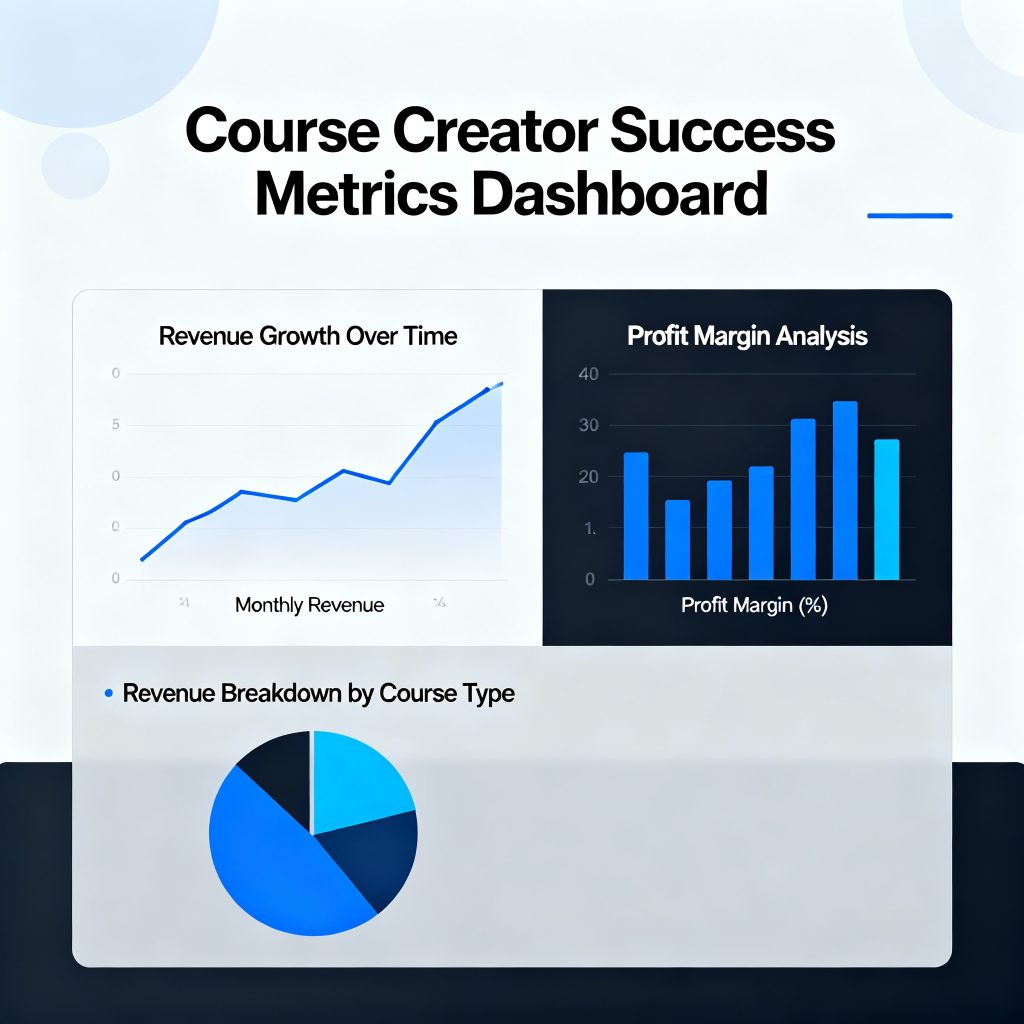
Marketing and Sales Funnel Development
Lead Generation and Audience Building
High-ticket courses require sophisticated marketing funnels generating qualified leads:
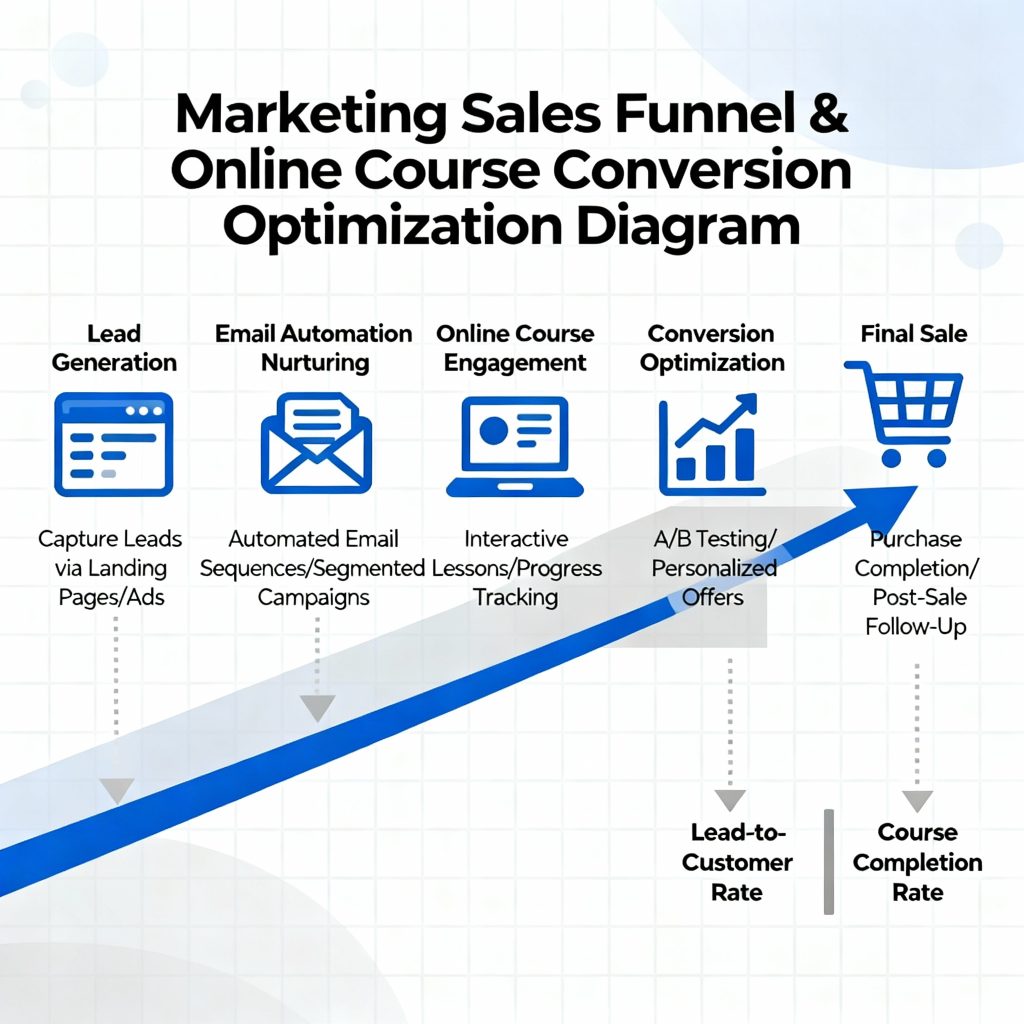
Content Marketing Strategy:
- Blog Content: SEO-optimized articles targeting course-related keywords
- YouTube Channel: Educational videos building authority and trust
- Podcast Appearances: Guest spots on relevant industry shows
- Social Media Presence: Consistent value-driven content across platforms
Lead Magnet Development:
- Free Mini-Courses: 3-5 lesson preview of your main course
- Comprehensive Guides: In-depth resources solving specific problems
- Templates and Tools: Practical resources your audience can immediately use
- Exclusive Webinars: Live training sessions with high perceived value
Email Marketing Automation
Sophisticated email sequences nurture leads and drive high-ticket sales:
Welcome Series (5-7 emails):
- Immediate value delivery upon signup
- Personal story and credibility establishment
- Social proof and testimonial sharing
- Soft introduction to premium offerings
Educational Series (10-15 emails):
- Deep-dive content building expertise perception
- Case studies and success stories
- Common mistake identification and solutions
- Progressive value ladder toward course offering
Sales Sequence (7-10 emails):
- Course announcement with early-bird pricing
- Detailed curriculum and transformation breakdown
- Objection handling and FAQ responses
- Scarcity and urgency creation
- Final opportunity messaging
Webinar and Masterclass Strategy
Live educational events remain highly effective for high-ticket course sales:
Webinar Structure Formula:
- Opening (10 minutes): Personal introduction and credibility establishment
- Content Delivery (40 minutes): High-value teaching with actionable insights
- Course Introduction (15 minutes): Logical transition from content to solution
- Q&A and Close (15 minutes): Objection handling and enrollment encouragement
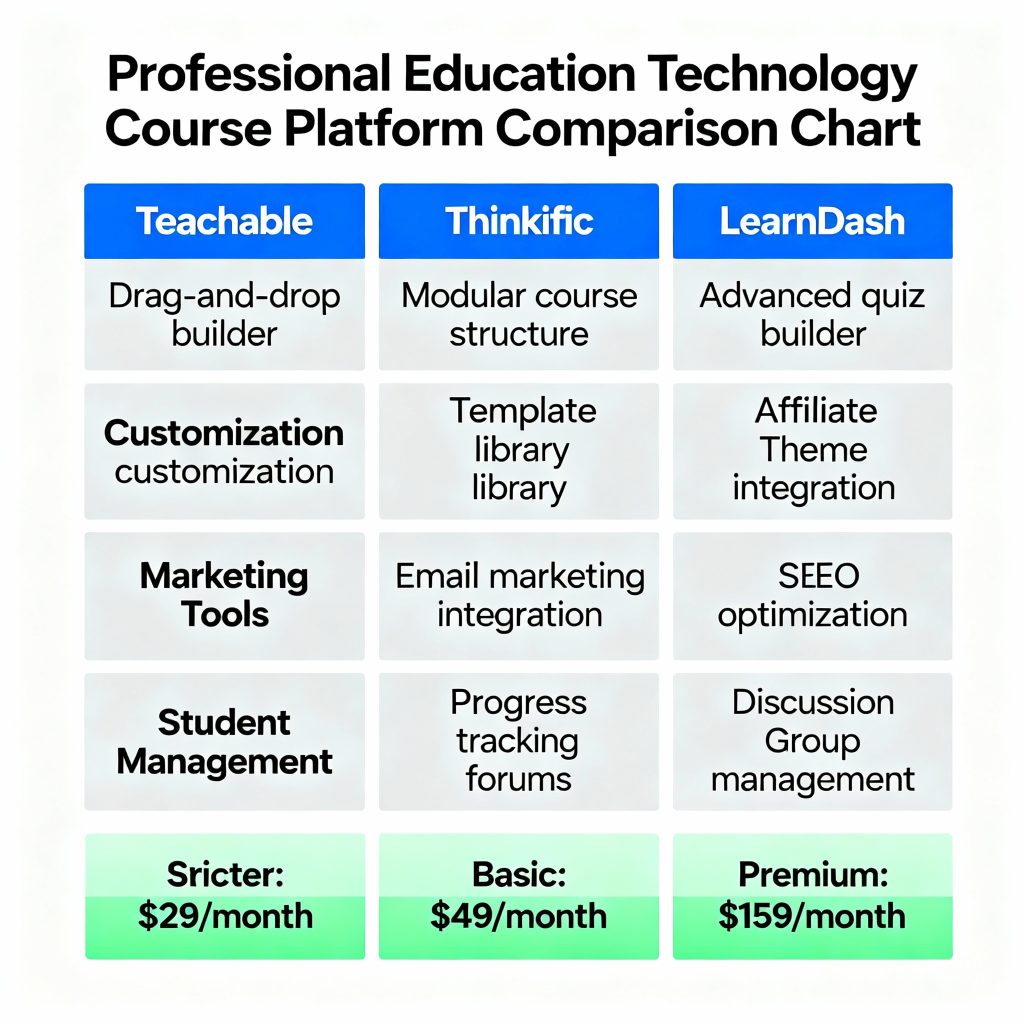
Platform Comparison and Technology
Comprehensive Platform Analysis
Selecting the optimal course platform impacts both student experience and business scalability:
Feature Comparison Matrix:
| Feature | Thinkific | Teachable | LearnWorlds |
|---|---|---|---|
| Course Creation | Advanced | Standard | Premium |
| Email Marketing | Built-in | Limited | Advanced |
| Community Features | Excellent | Basic | Premium |
| Pricing Flexibility | High | Medium | Very High |
| Analytics | Comprehensive | Standard | Enterprise-level |
| Mobile App | iOS only | Yes | Yes |
| Transaction Fees | None | Varies by plan | None |
Integration and Automation Tools
High-ticket courses benefit from sophisticated tool integration:
Essential Integrations:
- CRM Systems: HubSpot, Salesforce for lead management
- Email Platforms: ConvertKit, ActiveCampaign for automation
- Payment Processing: Stripe, PayPal for secure transactions
- Analytics Tools: Google Analytics, Facebook Pixel for tracking
- Webinar Platforms: Zoom, WebinarJam for live events
Success Metrics and Optimization
Key Performance Indicators (KPIs)
Monitoring specific metrics enables continuous course improvement and revenue optimization:
Revenue Metrics:
- Average Revenue Per Student (ARPS): Total revenue divided by student count
- Customer Lifetime Value (CLV): Total revenue per student across all purchases
- Conversion Rates: Percentage of leads converting to paying students
- Refund Rate: Percentage of students requesting refunds
Engagement Metrics:
- Course Completion Rate: Percentage of students finishing the entire course
- Student Satisfaction Score: Average rating from post-course surveys
- Community Participation: Active engagement in course forums or groups
- Implementation Rate: Students actually applying course teachings
Optimization Strategies
Continuous improvement drives long-term success and higher revenue per student:
Content Optimization:
- Regular curriculum updates based on student feedback
- Addition of new modules addressing emerging trends
- Improvement of low-engagement sections
- Enhanced interactive elements and assessments
Pricing Optimization:
- A/B testing different price points and payment plans
- Seasonal pricing adjustments based on demand patterns
- Bundle offerings combining multiple courses
- Upsell development for existing students
Marketing Optimization:
- Landing page conversion rate improvement
- Email sequence refinement based on open and click rates
- Social media strategy adjustment based on engagement
- Partnership development for audience expansion
Advanced Revenue Strategies
Scaling Beyond Single Courses
Successful course creators develop multiple revenue streams maximizing student value:
Course Ecosystem Development:
- Foundational Course: Entry-level offering building basic competency
- Advanced Specializations: Deep-dive courses for specific applications
- Certification Programs: Credentialed courses with higher perceived value
- Done-With-You Services: High-touch implementation support
Recurring Revenue Models:
- Membership Communities: Monthly subscription for ongoing access and support
- Coaching Programs: Regular group or individual coaching sessions
- Mastermind Groups: Peer-to-peer learning with instructor facilitation
- Annual Conference: In-person or virtual events for community building
Corporate and Enterprise Sales
B2B sales often generate significantly higher revenue per transaction:
Enterprise Course Packages:
- Team Training Programs: Bulk enrollments for corporate teams
- Custom Curriculum Development: Tailored courses for specific organizations
- White-Label Licensing: Allowing organizations to brand and resell your course
- Train-the-Trainer Programs: Enabling internal course delivery
Future Trends and Opportunities
Emerging Technologies
Course creators should prepare for technological developments reshaping online education:
Artificial Intelligence Integration:
- Personalized Learning Paths: AI-driven curriculum customization
- Automated Assessment: Intelligent grading and feedback systems
- Content Generation: AI-assisted course material creation
- Student Support: Chatbot integration for 24/7 assistance
Virtual and Augmented Reality:
- Immersive Learning Experiences: VR-based simulations and training
- 3D Modeling and Visualization: Complex concept illustration
- Virtual Collaboration: Enhanced group learning experiences
- Hands-On Practice: Safe environment for skill development
Market Evolution Predictions
Understanding future trends enables strategic positioning:
Increased Specialization: Courses targeting highly specific niches will command premium pricing as general education becomes commoditized.
Community-Centric Learning: Courses emphasizing peer interaction and ongoing support will differentiate from passive content consumption.
Outcome-Based Pricing: Payment models tied to student results and transformation will become more prevalent.
Micro-Learning Integration: Bite-sized content delivery will complement comprehensive course offerings.
YouTube Learning Resources
To complement this comprehensive guide, here are valuable YouTube channels and playlists for course creators:
Course Creation Fundamentals:
- “How To Create an Online Course For Beginners (6-Step Guide)” – Complete beginner tutorial covering essential steps
- “Thinkific Tutorial for Beginners: How to Create an Online Course” – Step-by-step platform walkthrough
- “How To Make Your Own Online Course With Canva For Free” – Free course creation using Canva
Platform-Specific Tutorials:
- “How to Create an Online Course Tutorials” playlist – Comprehensive creation guide
- “Use YouTube to Build a Course in 3 Steps” – Leveraging existing video content
Marketing and Validation:
- “10 Profitable Online Course Niches in 2025” – Market research and niche selection
- “How I Made $1,764,000 Selling Online Courses” – Real creator success story and strategies
Advanced Strategies:
- Course validation techniques and market research methods
- Pricing strategy implementation tutorials
- Email marketing automation for course creators
- Sales funnel development for high-ticket offerings
Conclusion
The high-ticket online course market represents one of the most lucrative opportunities in the digital economy. With proper validation, strategic pricing, quality content creation, and sophisticated marketing, course creators can build substantial businesses generating $100,000 to $1,000,000+ annually.
Success requires commitment to delivering genuine transformation, understanding your market deeply, and continuously optimizing your approach based on student feedback and market evolution. The creators who combine expertise with strategic business thinking will capture the greatest share of this expanding market.
The key differentiator between successful high-ticket course creators and those who struggle lies in their ability to solve urgent, valuable problems for specific audiences while building systems that scale beyond individual time investment. By following the strategies outlined in this guide and staying current with industry developments, you can position yourself for significant success in the growing online education market.

